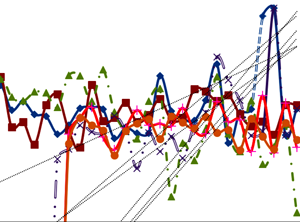Prediction of rain attenuation trend due to climate change in some locations of Southwestern Nigeria
DOI:
https://doi.org/10.3103/S0735272721010052Keywords:
Rain rate, Attenuation, Trend, VariabilityAbstract
Climate change has become a phenomenon of global concern and it has resultant effect on the variability of radio propagation. In recent times, the issue of climate change has been a global phenomenon having its resultant effect on the variability of radio propagation. High-capacity radio signal fades due to absorption by atmospheric gases and scattering by hydrometeors which limits the link availability. This study is aimed at investigating the effects of climate change trend via rain attenuation along the satellite-earth path over Nigeria’s climate. Rain rates computed by using the compensated function on Semire and Rosmiwati model were utilized to estimate rain attenuations and effective path lengths using ITU-R P.618-13 model on NIGCOMSAT-1R satellite at 0.01% exceedance for selected frequencies within Ku- and K-bands. Linear trend models for annual rain attenuation were also developed. At 0.01% time unavailability, the prediction of rain attenuation on NIGCOMSAT-1R link using ITU-R P.618-13 model ranged from 14 to 28 dB at Ku-band, and rose beyond 40 dB at K-band. This study inferred that trends of rain rate distributions corresponded to the trends in attenuation due to rain and then concluded that the rising trends of yearly signal outage along earth-space path as a result of increasing rainfall intensity was due to climate change in the study area. This outcome can be explored for better communication planning and design in order to provide reliable links in order to satisfy customers’ demand for high quality radio communication.
References
- S. J. Malinga, “Determination of Millimetric Signal Attenuation due to Rain using Rain Rate and Raindrop Size Distribution Models for Southern Africa,” 2014.
- U. WHO, Climate Change and Human Health - Risks and Responses. 2003, uri: https://www.who.int/globalchange/publications/cchhsummary/en/.
- A. Karaburun, A. Demirci, F. Kora, “Analysis of spatially distributed annual, seasonal and monthly temperatures in Marmara Region from 1975-2006,” Ocean J. Appl. Sci., vol. 5, no. 2, pp. 131–149, 2012.
- R. K. Crane, Electromagnetic Wave Propagation through Rain. John Wiley and Sons, 1996, uri: https://www.wiley.com/en-ua/Electromagnetic+Wave+Propagation+Through+Rain-p-9780471613763.
- R. Olsen, D. Rogers, D. Hodge, “The aR^b relation in the calculation of rain attenuation,” IEEE Trans. Antennas Propag., vol. 26, no. 2, pp. 318–329, 1978, doi: https://doi.org/10.1109/TAP.1978.1141845.
- F. Moupfouma, “Improvement of a rain attenuation prediction method for terrestrial microwave links,” IEEE Trans. Antennas Propag., vol. 32, no. 12, pp. 1368–1372, 1984, doi: https://doi.org/10.1109/TAP.1984.1143248.
- R. L. Freeman, Radio System Design for Telecommunications, 2nd ed. Wiley-Interscience, 1997.
- J. P. Verdin, “Famine Early Warning System Network (FEWS NET),” 2006. doi: https://doi.org/10.3133/fs20063022.
- F. A. Semire, T. I. Raji, “Characteristics of Measured Rainfall Rate at Ogbomoso, Nigeria for Microwave Applications,” J. Telecommun. Inf. Technol., no. 2, pp. 85–89, 2011.
- T. V. Omotosho, C. O. Oluwafemi, “One-minute rain rate distribution in Nigeria derived from TRMM satellite data,” J. Atmos. Solar-Terrestrial Phys., vol. 71, no. 5, pp. 625–633, 2009, doi: https://doi.org/10.1016/j.jastp.2009.02.003.
- G. O. Ajayi, S. Feng, S. M. Radicella, B. M. Reddy, Handbook on Radiopropagation Related to Satellite Communications in Tropical and Subtropical Countries. Trieste, Italy: ICTP, 1996.
- F. A. Semire, M.-M. Rosmiwati, “Development of rain rate prediction model for Nigeria,” Can. J. Pure Appl. Sci., vol. 5, no. 3, pp. 1721–1728, 2011, uri: http://www.cjpas.net/wp-content/uploads/pdfs/5/3/Oct-11_18.pdf.
- F. Abiola Semire, A. Adekunle, R. Olayimika Abolade, “A study on rain rate prediction of Southwestern Nigeria,” Phys. Sci. Int. J., pp. 1–12, 2020, doi: https://doi.org/10.9734/psij/2019/v23i430166.
- R. ITU-R, “Propagation data and prediction methods required for the design of Earth-space telecommunication systems,” in International Telecommunication Union Radio Communication P.618-13, Geneva, 2017.
- F. A. Semire, R. Mohd-Mokhtar, Z. K. Adeyemo, “Statistical analysis of rain height over Malaysia,” Radioelectron. Commun. Syst., vol. 59, no. 9, pp. 423–426, 2016, doi: https://doi.org/10.3103/S0735272716090065.


